Key Measurements for a Heavenly Stairway
http://decor-ideas.org 10/08/2014 03:13 Decor Ideas
Some stairways are easier to ascend than others, and there are reasons for that. The parameters of stair design are set by building codes, and there are also recommended configurations based on average human proportions.
There are, for example, tread-width-to-riser height relationships that make stairs more comfortable for the average person to traverse. Building codes set a minimum for staircase width, but wider dimensions are often necessary. Other important considerations are head clearance, railing dimensions and landings.
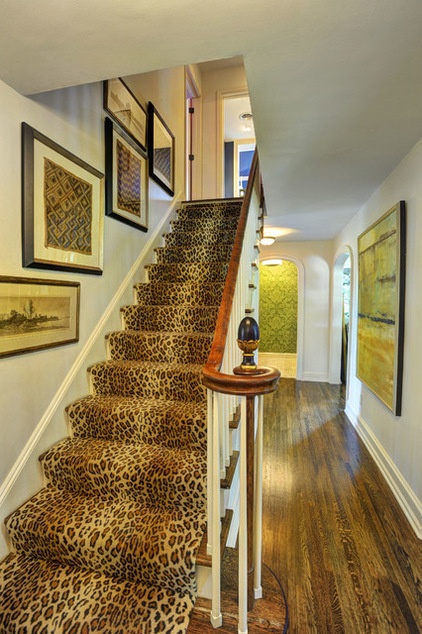
Square Footage
The length of the run is the total dimension the treads must occupy to complete the required rise. Staircases use significant square footage by the time all the steps are in place, landings are located and headroom has been cleared.
Consider that if a tread is 12 inches and you need 19 of them, that is 19 feet for the length of the steps alone. Now add at least 3 ft. on each end for landings, and you have 25 ft. in which to place that stairway path, at minimum. When you multiply the 25-ft. length times the 4-ft. width, which includes the railing and the wall, you have a 100-square-foot area that is required for that staircase. Double those figures to account for the hall or path to go around the staircase, and you have 200 square feet for one staircase. This is the size of a single-car garage.
Since they require so much space, efficient staircases must be designed. The trick is a balance of comfort and efficiency that satisfies the building code and enhances the architecture of the space.
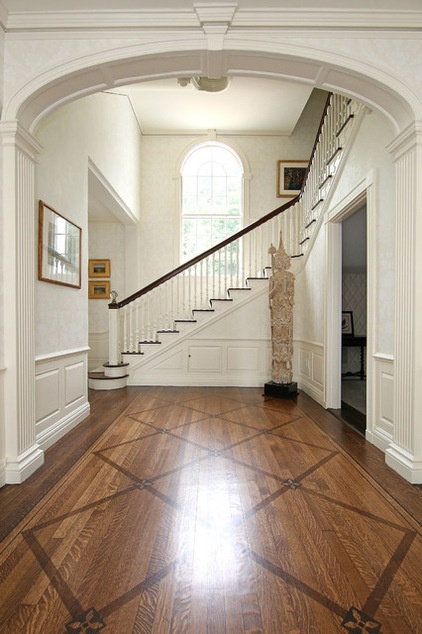
Risers and Treads
Critical to stair design are the height of each riser and the width of each tread.
All risers should be exactly or nearly the same height. Varying riser heights feel awkward and are difficult to ascend, because we need rhythm when we climb steps. Building codes also mandate equal heights, though slight variations (less than ⅜ in. per step) are acceptable.
There are some rules of thumb when planning stairs. One is: “Two risers plus one tread should equal 25 in. This works well in most circumstances. For example, you could have stairs with 7-in. risers and 11-in. treads (7 + 7 + 11 = 25), or you could have stairs with 7½-in. risers and 10-in. treads (7½ + 7½ + 10 = 25).
Those with generous budgets and space, however, may build steps that have 12-in. treads and 6-in. risers, and that equation is 6 + 6 +12 = 24. This configuration provides a gentler ascent and broader steps that feel easier on the body; however, it uses considerably more space.
The traditional architecture seen here shows a staircase that makes a gentle ascent with lower risers, wider treads and landings.
For many years the maximum rise allowed was 8 in. coupled with a 9-in. minimum tread. Newer codes mandate 7¾-in.-maximum risers with 10-in.-minimum treads.
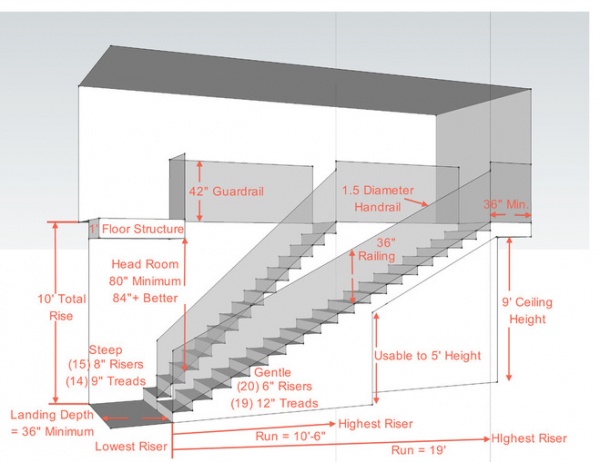
This simplified illustration calls out the key elements that must be considered in staircase design. Two extremes are presented: a very steep stair with 8-in. risers and a gentle stair with 6-in. risers. Critical is the run of the stairs. Clearly shorter risers will require much more space.
Most staircases fall somewhere between these two extremes. For example, a staircase with 7-in. risers and 11-in. treads creates a comfortable ascent for most people.
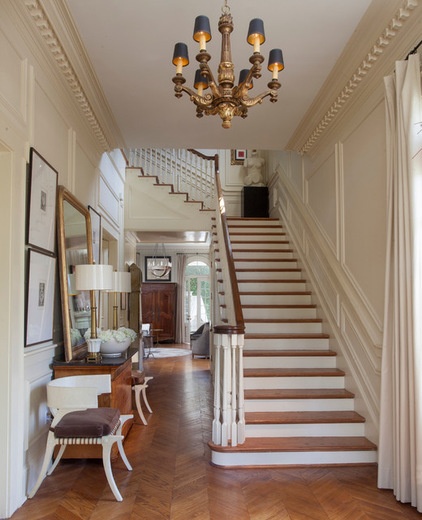
The total height of the rise of a staircase depends on the height of the ceiling and depth of the upper-floor structure. With a taller ceiling, such as the one pictured, more risers and treads are needed to make the staircase function.
For example, if your risers are 6 in. each and your ceiling is 9 ft. high with a 1-ft. upper-floor-structure depth, you will have to ascend 10 feet. It will take 20 6-in. risers to make it all the way up. If we can increase the risers to 8 in. each, we will need only 15.
So, when you have 20 6-in. risers, you will need 19 12-in. treads for a total stair run of 19 feet. When you have 15 8-in. risers, you will need 14 treads of only 9 in. each. Now your stair run needs to be only 10 ft., 6 in. The run is significantly shorter and takes up much less square footage.
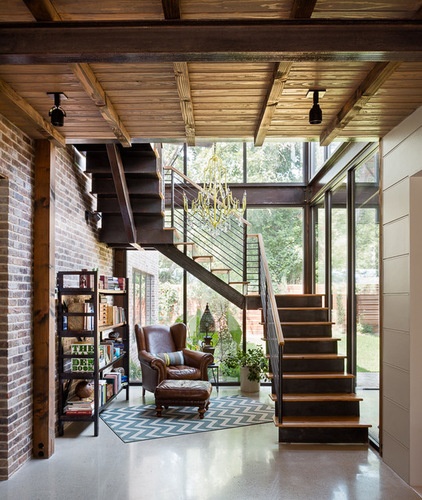
There are many other minor but important details in stair design. The nose of the tread, which overhangs the face of the riser (or not), is one; limitations on it are set by building codes.
Stairs can be fully supported by walls from underneath or the sides, or they can seem to float in space by the assistance of steel structural elements.
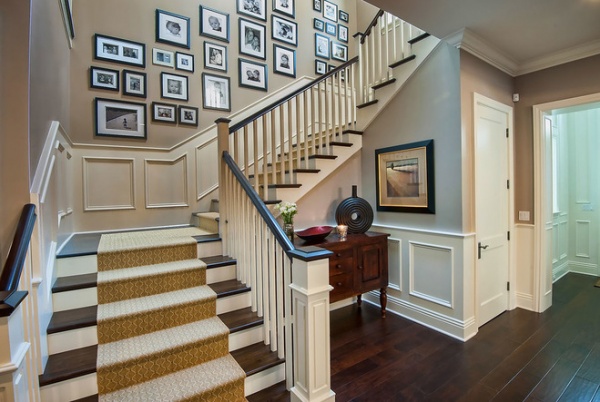
Staircase Width
Most current building codes mandate that the clear width of a staircase be 36 in. between finish materials. Whether this dimension is sufficient depends on how the stairs will be used and whether they will have an open railing or will be enclosed by walls.
Bumping up the dimension just 4 in., to 40 in., in width can make a significant difference in how comfortable it will be to use that staircase.
If you think you will often have one person going up while one is coming down, you should make your staircase about 48 in. wide. Wider than that will be more costly or impractical, or the stair will be uncomfortable to use — and if it is too wide, you won’t be able to reach a handrail on the side of the stairs if you ascend in the center.
A generous width and two landings make this staircase easy to navigate.
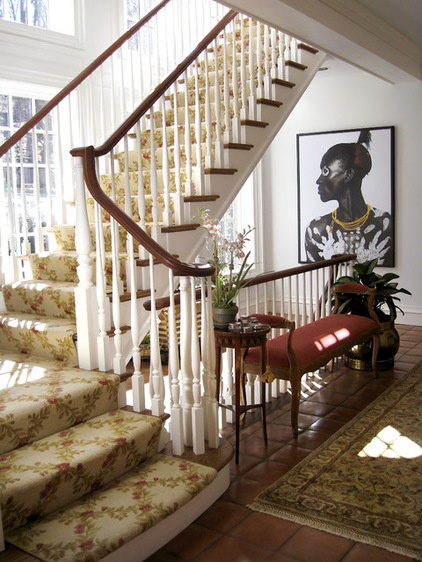
Stacking Staircases and Head Clearance
In a multistory structure, stacking staircases makes practical sense for configuration and traffic flow.
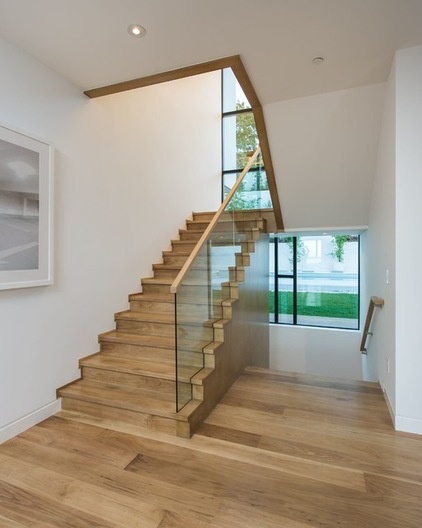
The minimum head height clearance per most building codes is 6 ft., 8 in. (80 in.) above the front edge of any tread, which is quite low. It is best to allow as much head height as possible, and 7 feet at minimum.
You will see many designs in which the staircase is placed within a two-story space that easily takes care of this issue. When you have three or more floors, stacking the staircases is the best solution. The head height from one follows the one above.
This arrangement also helps create a compact and efficient traffic flow. Incidentally, the space below the stairs becomes impractical for use once the head height falls below 5 ft. Unless you are really tight for space, consider that area spent.
This photo shows how head clearance is critical at overhanging floors and adjoining staircase ceilings.
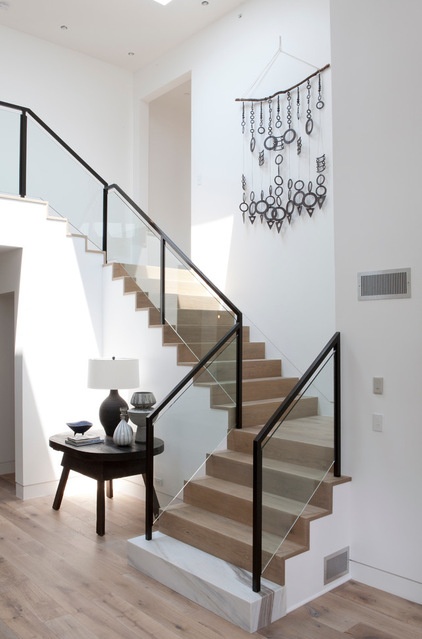
Landings
Landings are the floor space at the top or bottom of the staircase, as well as the platform created at some midpoint along the path of the steps.
When the total stair height is significant, as with a 10-ft. ceiling, landings can break up the run and make ascending these staircases a little easier, since they provide a point to pause on the way up and down the steps.
Landings need to be at least 36 in. square or as wide as the stairs, but often should be larger to be more comfortable. They can provide architectural interest and help make a staircase more visually pleasing.
In no instance should a stair be designed in a single run with a total rise of more than 12 feet. Landings should be provided for stairs beyond that dimension, and are advisable where the ascent exceeds 9 feet.
In the contemporary staircase pictured, the landings add both function and beauty.
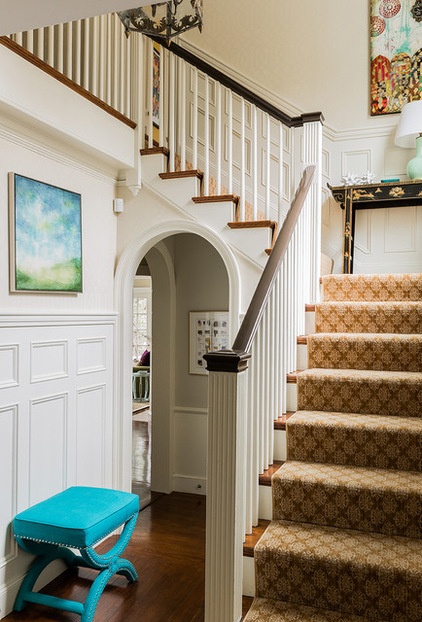
Guardrails and Handrails
The railing that runs up the side of an open staircase should be 36 in. above the nose of the treads. The guardrail around the stair opening is usually 36 in. high, but in the new codes this dimension has increased to 42 in. Openings in railings and guardrails cannot be larger than what would let a 4-in. sphere pass through them.
The handrail that tops the railing has specific dimensions according to which building code is used and the type of structure being considered. A handrail diameter of 1½ in. is most common.
The staircase pictured here has a traditional railing with an open balustrade and detailed treads.
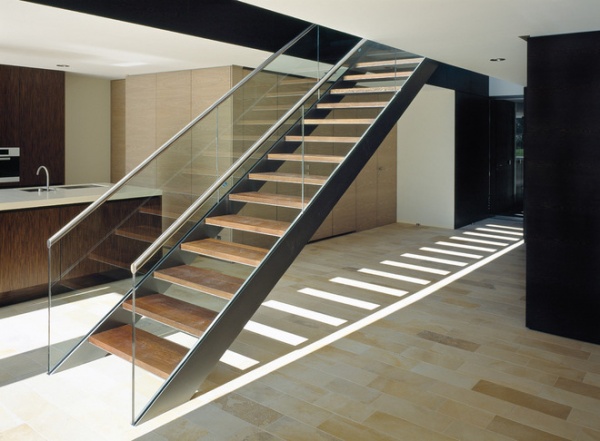
This contemporary staircase has curbed risers with a glass railing and a metal handrail.
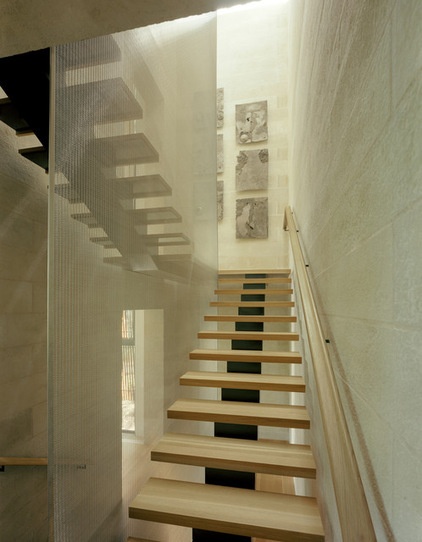
Staircases can be enclosed by walls, which eliminates a railing; however a handrail is still required and must be detailed with careful consideration to applicable building codes. This modern staircase between walls has only a handrail.
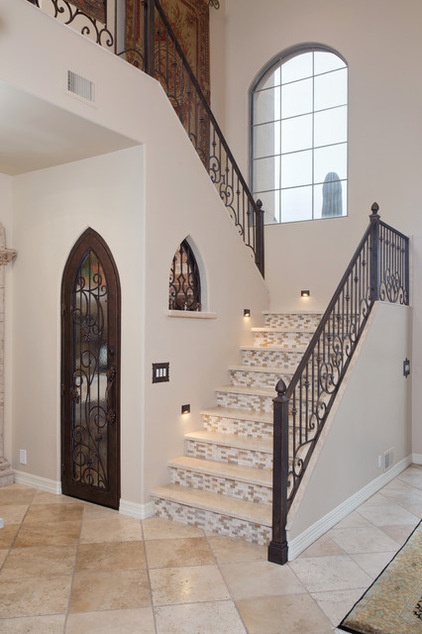
Balustrades
Traditional stair designs usually have open balustrades that reveal the outside end of the stair treads. Open balustrades with curbs enclose the ends of the treads with the supporting wall or stair structure. Closed balustrades are designed where two walls line the edges of the staircase.
Open-ended treads usually cost more to build, because the detail of the edge of the tread is intricate and requires superior finish work. Curbed treads can be simpler and easier to construct. Both types can be detailed in traditional or modern fashion.
Pictured here is a stairway with an open balustrade and curbed treads.
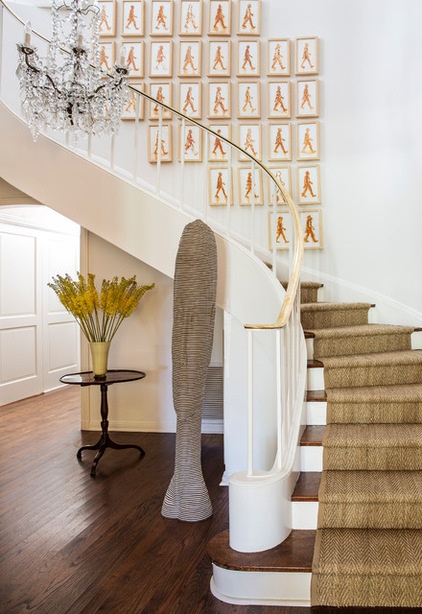
This winding staircase has curbed treads and an open balustrade.
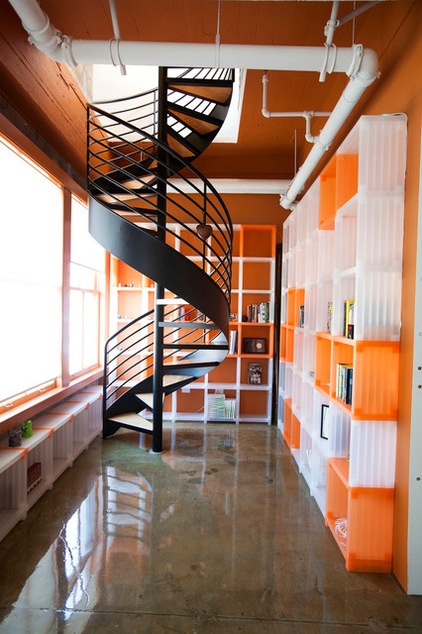
Spiral and Winding Staircases
Spiral and winding staircases are beautiful, and they are also complex. Building codes mandate minimum and maximum dimensions that must be applied to the rise and run of spiral staircases.
It’s advisable to leave the design of these stairs to seasoned professionals. Very narrow steel spiral stairs with steps that radiate from a center post were at one time quite popular. While you may have one of these or wish to place one in your house, they often do not comply with building code egress requirements, so consider this circumstance carefully.
Stair design lies on the more complex end of architectural elements, and highly detailed staircases are expensive. Work with the best design professionals and expert carpenters and contractors to ensure that yours is successful and beautiful.
Browse more Key Measurements ideabooks
Related Articles Recommended












